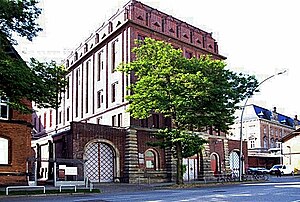Hamburg pre-trial detention center
 Main entrance area, Holstenglacis 3 |
|
| Information about the institution | |
|---|---|
| Surname | Hamburg pre-trial detention center |
| Reference year | 1881 |
The Hamburg Pretrial Detention Center ( UH A) in the Hamburg penal system , formerly also the mother institution or called Dammtor for prisoners , is located on Holstenglacis Street. All arrested persons in Hamburg (several thousand per year) are initially housed here.
The pre-trial detention center serves as a pre-trial detention center , a police detention center , an institution for civil detention (e.g. coercive detention), a demonstration department for court hearings and a transport department. It also has a prison (central hospital-ZKH). There are underground corridors between the building and the criminal justice building .
The UHA has (as of the end of 2018) 482 prison places and 47 beds in the central hospital. There are a total of approx. 400 jobs in the institution.
history
The remand prison was built in the years 1877–1881. The panoptic construction, which u. a. was also used in the prison in Fuhlsbüttel , allowed a view into all wings of the building at that time. Initially, only solitary confinement places were set up.
The reception building (House A) and the women's department of the UHA followed by 1930. In addition, another wing with detention areas was completed. There are no solitary confinement rooms in this, but rooms for up to eight prisoners. The administrative wing of the UHA was completed in the same period. There are no cells here.
Central execution site

On December 28, 1936, the Reich Ministry of Justice stipulated that executions in 11 selected penal institutions in the Reich were to be carried out with the guillotine . The remand prison in Hamburg-Stadt was designated as a location for the " central execution site for Execution District V " until 1944 and in 1938 it was equipped with an execution wing and a new guillotine made in Berlin-Tegel . By 1944, 468 executions had been carried out in the courtyard and in the disinfection room of the UHA. The most famous victims include the so-called Lübeck martyrs , the three Catholic priests Johannes Prassek , Eduard Müller and Hermann Lange, as well as the Protestant pastor Karl Friedrich Stellbrink , who were beheaded on November 10, 1943. In addition to the entrance to the prison on Holstenglacis and also on the back of the site, on a wall in the Kleine Wallanlagen , memorial plaques and stumbling blocks remind of the victims, on the one hand in general and in particular on the Lübeck martyrs as well as Suzanne Masson and France Bloch-Sérazin , two women from the French Resistance who were also executed there in 1943. The last three executions took place in the remand prison on December 15, 1944. Then the guillotine was taken to the Bützow-Dreibergen prison; she worked there until the end of the war.
After the Second World War
After the Second World War , the institution continued to be used as a place of punishment and execution. From December 14, 1945 to May 9, 1949 , the British occupying forces had 15 men executed for, among other things, murder, possession of weapons and war crimes. In the 1950s, 1960s, 1990s and 2000s, various renovations and renovations were carried out in the remand prison, including: a. the central hospital of the Free and Hanseatic City of Hamburg was built. Afterwards, the previously unrenovated wings of the UHA were renovated in individual construction phases. This has improved the quality of the accommodation while still maintaining the style of this institution.
The A-wing of the institute has been in operation again since October 1st, 2009 after an extensive refurbishment.
The completely renovated B-wing was put into operation in mid-2018, so all areas of the institution have been renovated at least once. Detention rooms without a power connection are history in the UHA Hamburg.
Material jurisdiction
The pre-trial detention center is responsible in the district of the Hanseatic Higher Regional Court for the execution of the pre-trial detention of adult male and all female pre-trial detainees. The underage male prisoners on remand are transferred to the Hahnöfersand prison.
Police custody
In contrast to other federal states, all those temporarily arrested in Hamburg are also placed in the remand prison until they are heard by the judge . This is unique in the Federal Republic of Germany as the police hand over their prisoners to the penal system before an arrest warrant is issued .
Central Hospital
Doctors, nursing staff and other employees work in the central hospital. Selective surgical interventions are performed here; there is an X-ray department, EEG and gastroscopy . There are also specialist medical consultation services . Prisoners from Hamburg, Schleswig-Holstein and Lower Saxony receive outpatient and inpatient medical care here.
literature
- Horst Gädtke: time, death and eternity . Books on Demand GmbH, Norderstedt 2006, p. 290 f. ISBN 3-8334-0491-4
- Martin Krieger: History of Hamburg . Knowledge series, Verlag CH Beck , Munich 2006, p. 100 f. ISBN 978-3-406-53595-6
- Andreas Seeger, Fritz Treichel: Executions in Hamburg and Altona 1933–1944 . State Center for Civic Education Hamburg 1998, ISBN 3929728397
Web links
Individual evidence
- ↑ press release. Hamburg judicial authority, accessed on April 16, 2019 .
- ^ Matthias Gretzschel: A guillotine as a museum piece. In: Hamburger Abendblatt from January 30, 2014, p. 19.
- ^ Andreas Seeger / Fritz Treichel: Executions in Hamburg and Altona 1933 - 1944 , Hamburg 1998, p. 18
- ↑ Andreas Seeger / Fritz Treichel: Executions in Hamburg and Altona 1933 - 1944 , Hamburg 1998, p. 9
Coordinates: 53 ° 33 ′ 29.1 ″ N , 9 ° 58 ′ 44.3 ″ E



